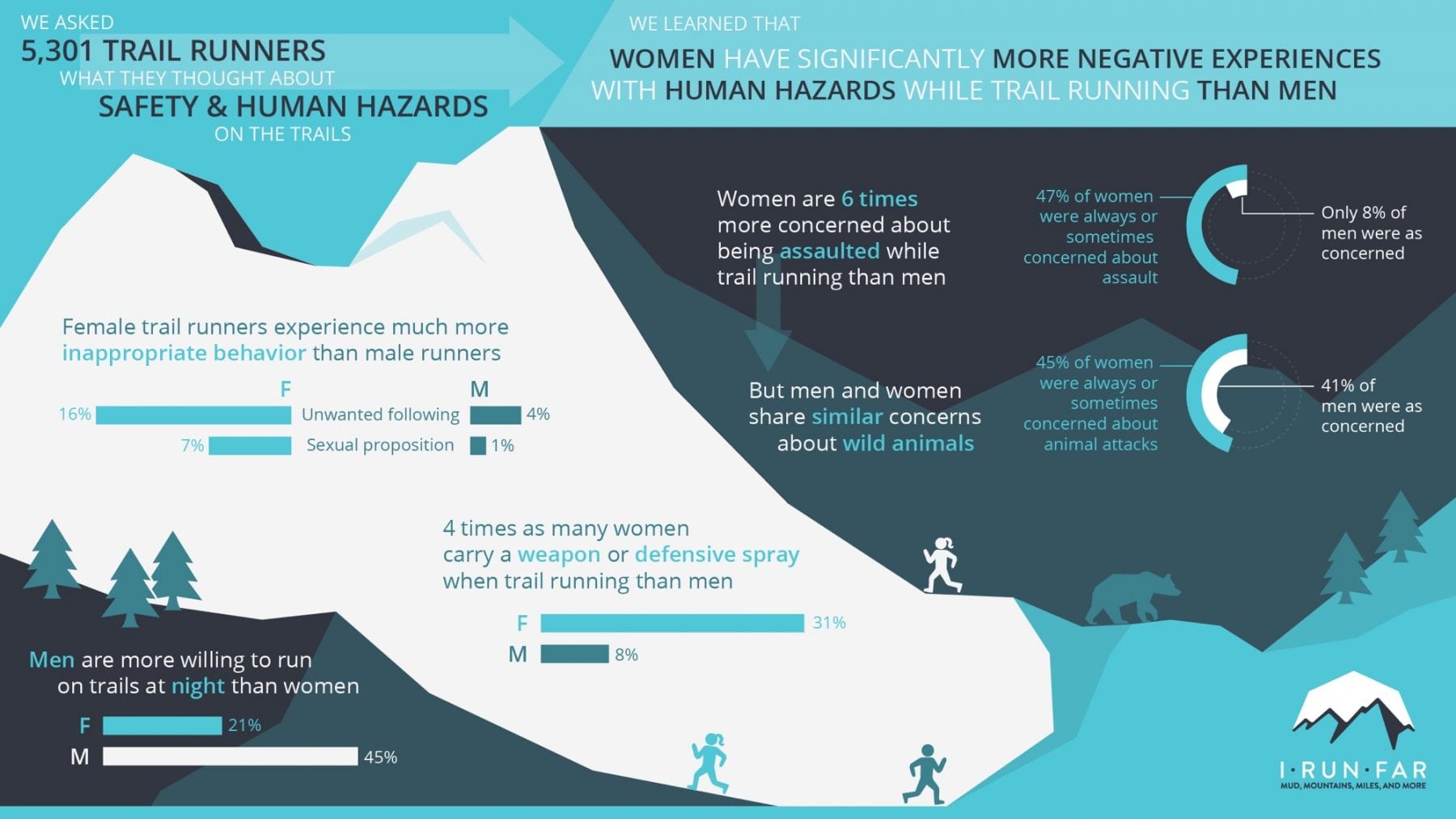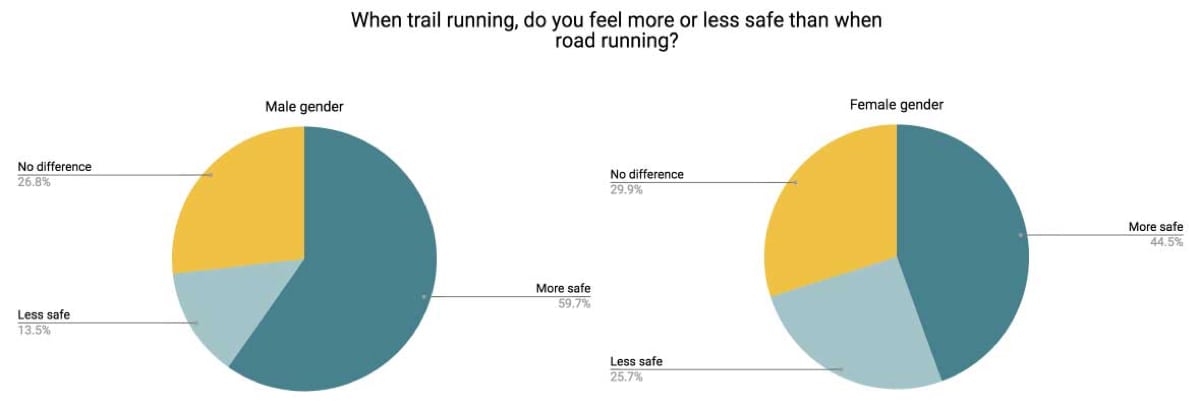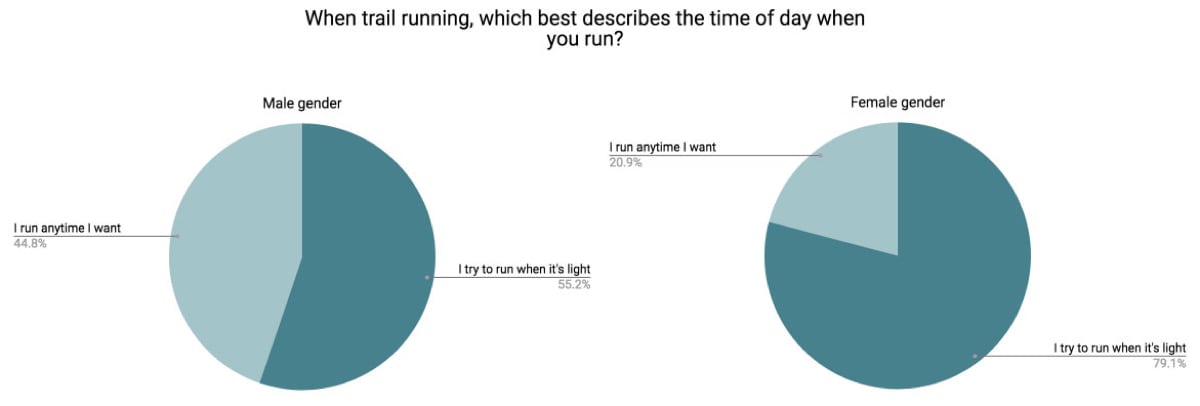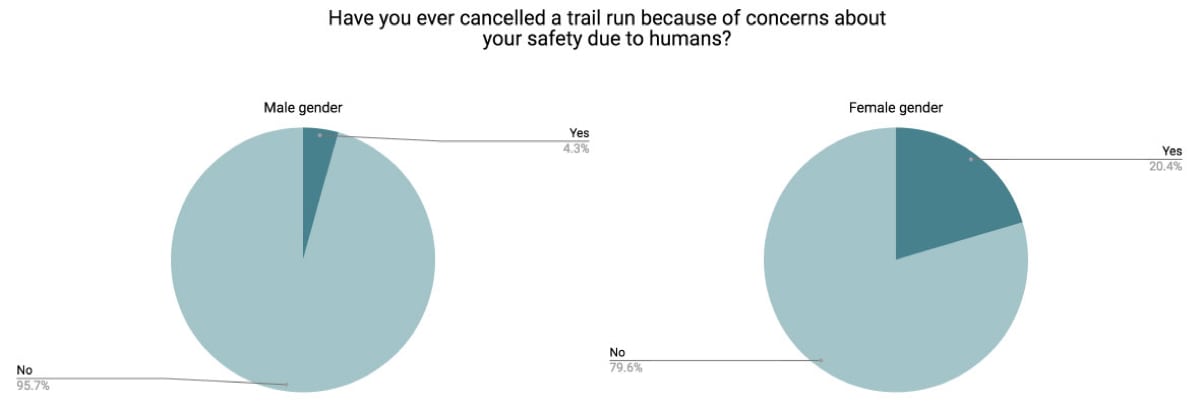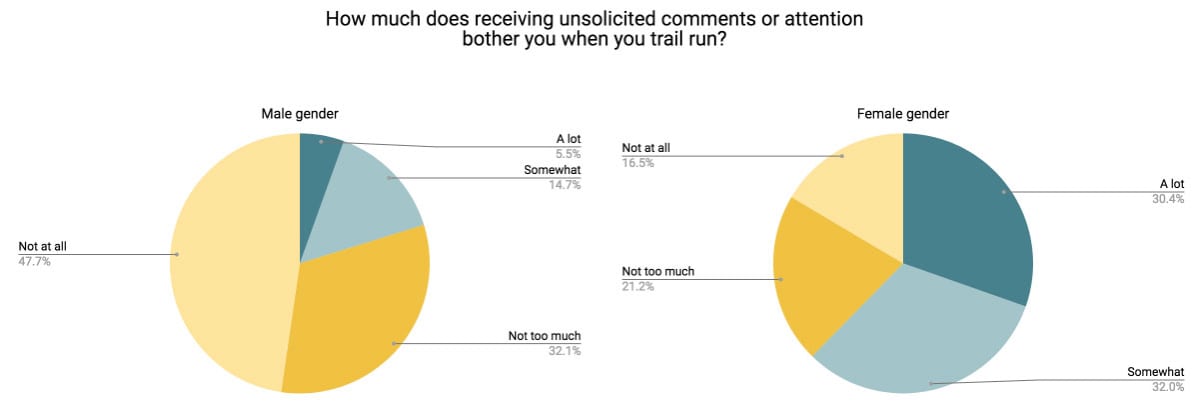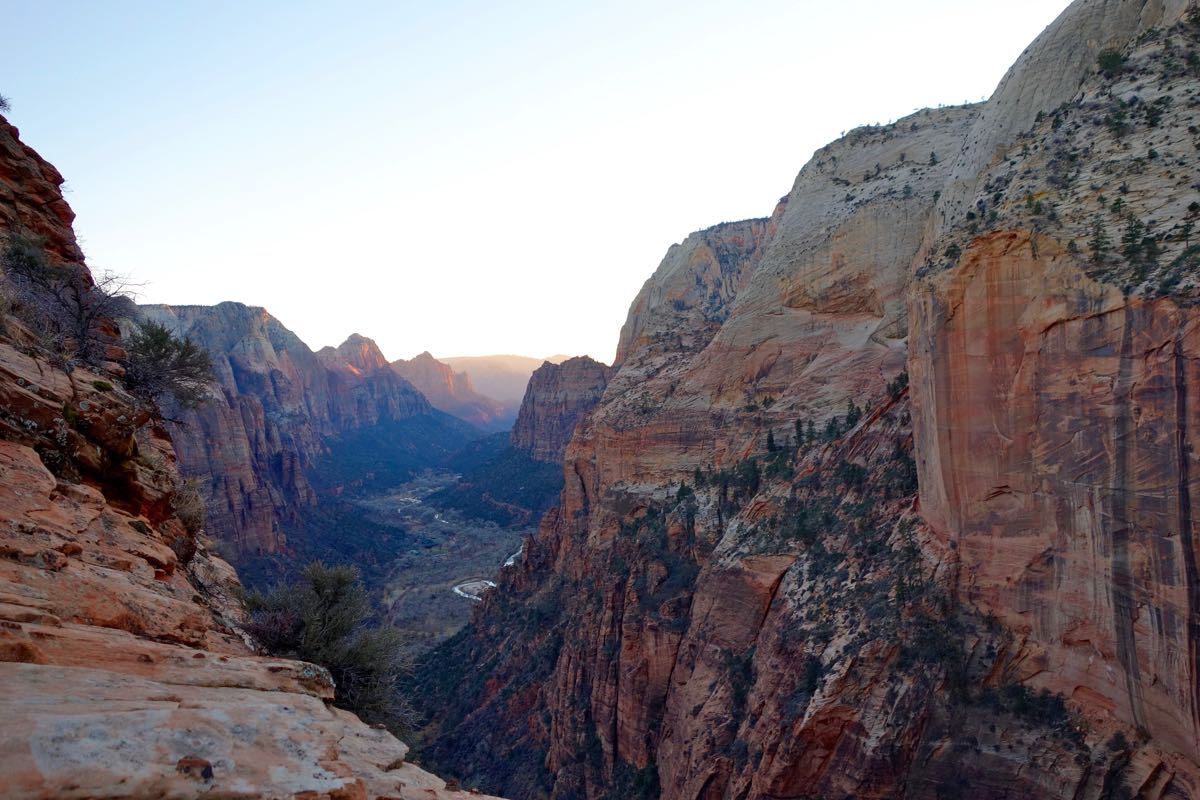Six months ago, iRunFar’s Trail Sisters decided to write an article about women’s safety from human hazards while trail running. The more research we all did, the more we understood how much we didn’t understand. A story idea became a survey. A survey involved a team of people helping us do it right. The survey created a lot of data to process. And the results needed to be interpreted in an accessible-for-all way. Liza Howard, of the Trail Sisters, jokingly called the project the ‘albatross.’
What we now know as a result is that female trail runners, across the board, are more challenged by human-safety hazards than male trail runners. Specifically, while trail running, females:
- Are more concerned about human hazards than males;
- Change their behavior to help maintain their safety from perceived human hazards more than males; and
- Experience verbal harassment and inappropriate behavior more than males.
The survey’s results are nuanced, as they always are, so consider this is the highlights reel. Dig deep into this long article to explore what we learned.
The survey’s results are grim for female trail runners when it comes to perceived danger of and actual exposure to human hazards. And it’s not just some women in a few cases; the statistics tell us that it’s a lot of women in many cases.
I hope we can move forward together with open minds and hearts. We trail runners are a close-knit community and all of us should dislike the fact that women–or anyone–find our trails unsafe because of humans.
In historic seafaring literature, the ship-following albatross was a symbol of both luck and a lack of it. I propose that the albatross becomes our positive metaphor. The knowledge we now have can be the foundation of a profound transformation for women on the trails.
Meghan Hicks
Managing Editor, iRunFar
Introduction
Back in November, iRunFar’s Trail Sisters–Liza Howard, Pam Smith, and Gina Lucrezi–asked you to help us better understand fears and safety issues in trail running via a survey. In the two weeks that the survey was open, we got a whopping 5,301 responses. Our heartfelt thanks to all those that took the time to answer our questions!
We were initially drawn to this topic after a female trail runner was attacked in an urban park near Liza’s home in San Antonio, Texas last September (news report). In fact, three other female trail runners had been attacked in nearby Austin between August and September 2017 (news report after third attack). But it was comments on social media faulting the victims of these attacks for putting themselves in unsafe situations by trail running that finally galvanized us to start writing.
Then Liza came across a 2016 survey and article in Runner’s World that explored women’s experiences being harassed while road running. The survey data made us question whether female trail runners have significantly different experiences, concerns, and perceptions about safety and human hazards than male trail runners do. None of us had ever really considered how this facet of trail running might be markedly different for female and male runners. Do women anticipate some level of harassment or unwanted sexual attention as trail runners? And men don’t? It was an ‘aha moment’ for us all.
We decided we needed to actually survey the trail running community to find out. With Runner’s World’s permission, we modified some of their survey questions to better suit trail runners. View iRunFar’s survey as well as the raw-form data collected in it. In this article, we present the results and, when possible, compare and contrast your responses with the responses from our road running counterparts.
A note on mechanics, the results are presented in written and graphic form, but for brevity, a majority of the graphics are collapsed. Click on the links throughout the article to open them.
In the near future, we’ll follow this up with an article and conversation that explores what our community can do with what we’ve now learned.
Respondent Demographics
We collected five pieces of demographics data from each respondent:
- Gender
- Age
- Geographic location
- Years of trail running experience
- Running environment
Let’s break down the demographics of those who participated in the survey.
Gender
Of our 5,301 respondents, 54.5% were male and 45% were female. Because women are a smaller segment of the trail running community and iRunFar readership, we were thrilled to have this level of participation by females. See respondent gender data in chart and numeric forms.
The gender breakdown in the Runner’s World survey was almost the exact opposite of ours with 45.7% male and 54.3% female respondents. They had fewer total respondents than we did at 4,670.
It is important to note that the iRunFar survey also had a broader list of gender choices than the Runner’s World survey. Roughly 0.3% of participants answered as a “non-binary/third gender” or “self described” gender, which were too small of sample sizes for analysis. So, this results article focuses on male and female responses.
Age
The majority of our responses came from runners between the ages of 30 and 49. This distribution was similar across genders. See respondent age data in chart and numeric forms.
The under 20 age group, representing just 0.6% of the respondent population, is also too small a sample size, so it isn’t included in the results analysis.
Geographic Location
Most of the responses came from the United States, but runners from Canada, Europe, and other parts of the world also weighed in. Almost half of the U.S. respondents hailed from the Pacific and Mountain regions of the country. See respondent geography data in chart and numeric forms.
Years of Trail Running Experience
Almost half of the trail runners who responded had between 3 and 10 years of trail running experience. More than a quarter had been running trails for 1 to 3 years, and about a fifth were veteran trail runners with more than 10 years under their belts (and belt buckles). We received relatively few responses from newbie runners with less than a year on the trails. See respondent trail running experience data in chart and numeric forms.
Running Environment
Interestingly, almost half of the runners who took the survey live in rural/remote areas. Most of the rest of the respondents call suburbia home. Unsurprisingly, fewer trail runners choose to live in cities. See respondent running environment data in chart and numeric forms.
Runners’ Concerns
The survey contained 10 questions in 3 focus areas, asking runners:
- To share their concerns about human and wild-animal hazards on the trail;
- Whether and how they modify their behavior while trail running because of potential human hazards; and
- To identify experiences of inappropriate behavior and verbal harassment on the trail.
This section explores answers to the questions asked about concerns with human hazards.
Question 1: As you prepare to go on a trail run, how often are you concerned you could be assaulted or attacked by another person.
View the original survey and read this question in full.
The vast majority of respondents said they are “rarely” or “never” concerned about being attacked by another person while trail running. See this data in chart form.
Women Versus Men
There is a striking gender difference between respondents. While more than half of men are “never” concerned about being attacked by another person while trail running, only 14% of female respondents felt the same. And only 8% of men are “always” or “sometimes” concerned about being attacked by a human, compared with close to half the women who responded.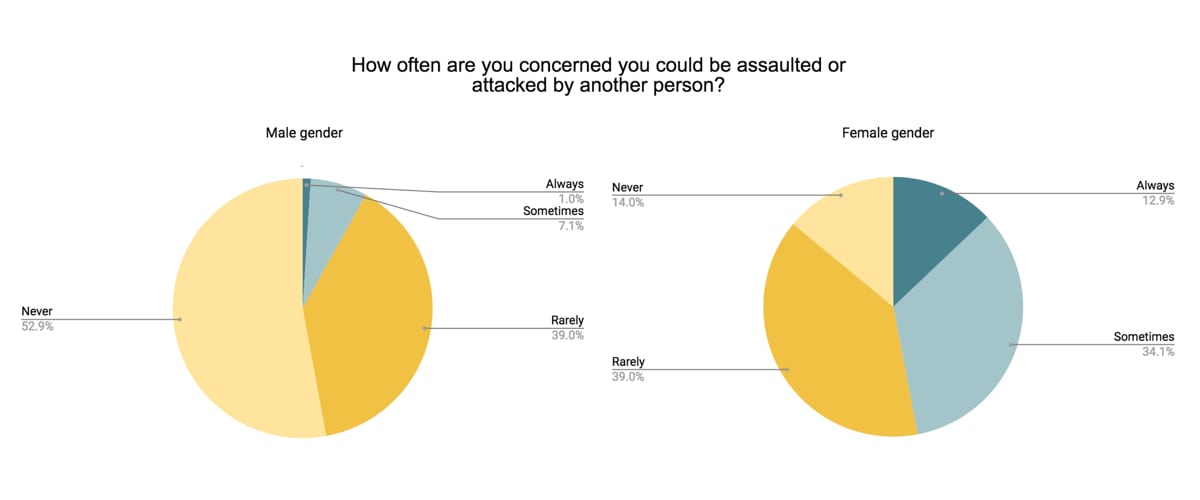 This gender difference on the trails mirrors runners’ experiences on the roads. The vast majority of both trail and road running men “rarely” or “never” have concerns about being assaulted while running, whereas only around half of trail and road running women feel the same lack of concern. Also, note that trail and road-running males share almost the same amount of concern, while road running females have more concern than their trail counterparts. See this data in chart form.
This gender difference on the trails mirrors runners’ experiences on the roads. The vast majority of both trail and road running men “rarely” or “never” have concerns about being assaulted while running, whereas only around half of trail and road running women feel the same lack of concern. Also, note that trail and road-running males share almost the same amount of concern, while road running females have more concern than their trail counterparts. See this data in chart form.
Other Demographics Trends
Good news! One factor that affected the amount of concern both men and women had was the number of years they’d been running. The longer you run, the less concerned you are that you’ll be attacked by someone. This is a particular boon for female trail runners whose daily runs are colored by these concerns more than men’s are. Of course, it’s important to recognize that non-event feedback, the ‘nothing happened to me last time’ evaluation, can be a hazard in and of itself.
The men who responded had slightly more trail running experience than the women did. 74% of the male cohort had three or more years of trail running while only 62% of the females had that many years on the trail. This difference doesn’t explain the huge disparity in women’s and men’s safety perceptions, but it clearly has an impact. The higher incidence of inappropriate behavior and verbal harassment female trail runners face may diminish the effect experience has on their concerns.
See this data in chart form.
Unsurprisingly, where you run also affects how concerned you are about being attacked by another person. More trail runners feel safe from human hazards while running in rural and remote areas than on urban trails. See this data in chart form.
We also see variations in concern levels based on where in the world a trail runner lives. Europeans are the least concerned about being attacked by another person. Most said they are “never” or “rarely” concerned about assault. See this data in chart form.
European respondents have a much higher rate of rural running than North Americans and runners in the rest of world. They also have more experience trail running than these two groups. These factors likely impact their perceptions of human danger.
Question 3: When trail running, do you feel more or less safe that when road running?
View the original survey and read this survey question in full.
The vast majority of respondents said they feel “no difference” or “more safe” on trails compared to roads. See this data in chart form.
Women Versus Men
Take a look at the statistically significant difference between how men and women answered this question. About double the number of women as men feel trail running is less safe than road running.
Other Demographics Trends
Of course, what kind of environment respondents trail run in affected how they answered this question. Those running in urban environments indicate they felt trail running was less safe than road running 27% of the time, and those running in rural/remote environments said the same only 15% of the time. See this data in chart form.
Respondents’ years of trail running experience impact answers. The longer you are a trail runner, the more safe you think trail running is compared to road running–by a whopping amount. See this data in chart form.
Question 10: As you prepare to go on a trail run, how often are you concerned you could be attacked by a wild animal?
View the original survey and read this question in full.
Although this survey focused on exploring concepts of safety from humans while trail running, we asked trail runners about their concerns about being attacked by a wild animal so we could examine how respondents gauge the risk of an environmental hazard (attack by a wild animal) versus a human hazard (assault or attack by a person), which we asked respondents about in Question 1. What follows are comparisons between answers to Questions 1 and 10.
The total number of respondents who were “always” concerned about human attacks was almost the same as the number who were “always” concerned about being attacked by a wild animal. But far fewer runners discounted the possibility of wild-animal attacks. Only 15.2% said they were “never” concerned about being attacked by a wild animal compared to 35.5% who “never” worried about being attacked by another person. See this data in chart form.
Women Versus Men
Women and men answered similarly regarding their concern about being attacked by a wild animal. But note the higher proportion of females who “always” feel concerned about an attack by a wild animal compared to men.
What we learn through this comparison is that while men and women share similar concerns about wild-animal attacks, they think very differently about the possibility of human attacks. Men are much less concerned about being attacked by another person. Look back at the data from Question 1 in chart form.
Other Demographics Trends
Predictably, respondents from geographic regions with more wild landscapes and predatory mammals were more concerned with animal attacks. The U.S. and Canadian groups had a much higher concern about animal attacks than their European counterparts and runners living in other parts of the world. Bears and mountain lions, oh my! See this data in chart form.
We are fascinated by the variations in how this question was answered by trail runners of varying ages. The age 20 to 29 bracket expressed the most concern among all the age groups, reporting in at almost half the group being “sometimes” or “always” concerned. And from age 30 on up, levels of concern decrease in each increasing age group. We guess, the older you get, the less you think something that can eat you, will eat you? See this data in chart form.
Here’s a fun demographics-trend variation. Trail runners with 1 to 3 years of trail running experience expressed the most concern about a wild-animal attack, more than trail newbies with less than 1 year of experience. A little knowledge about what’s ‘out there’ is enough to cause concern, perhaps? More predictably, perhaps, runners with 10 or more years of experience expressed the least concern. See this data in chart form.
Runners’ Safety Behaviors
In this section, we explore answers to the 4 questions asked in the survey regarding trail runners’ behavior with regards to their safety from humans.
Question 4: When trail running, which best describes the time of day when you run?
View the original survey and read this question in full.
Give them headlamps, and they will run. A third of trail runners don’t care if it’s light out or not; they trail run anyway. See this data in chart form.
Women Versus Men
Once again, there is a marked difference between women and men. 79% of women limit their trail running to daylight hours. Only 55% of men do the same.
Other Demographics Trends
All demographics but age affected the way respondents answered this question. And some of the differences were equally radical to the above-described gender differences. For example, residents of different world regions differently approach trail running at night versus during the day. Some 53% of Europeans run any time of day, which adds up to 20% more than USA/Canada trail runners. See this data in chart form.
Now let’s zoom in on North American regions and their night-and-day trail runners’ play. Hey, U.S. Mountain region and Canada, here’s looking at you and how those who trail run in your region don’t mind the dark as much! See this data in chart form.
You might predict that trail runners with a lot of years of experience trail running are more inclined to run at any time of the day–makes logical sense and the data agree with you. But what we found really interesting was that increasing a respondent’s age didn’t make them more likely to run at any time of day. In fact, the age 60 or over group was the least-likely-to-run-anytime-of-day group and the age 30 to 39 group was the most likely! We wonder, is this an expression of the schedule freedom that retirement can bring versus people in the height of their professional and personal lives? See this data in chart form.
Question 5: Which of these [safety factors] do you think of when choosing a particular running route? Check all that apply.
View the original survey and read this question in full.
The biggest safety factor that trail runners consider before undertaking a run is the number of other people who usually use the route with more than a third of respondents considering this. See this data in chart form.
Women Versus Men
Women were influenced by the number of people using the route, reports of harassment, the ability to flee or get help, and the availability of cell phone reception significantly more than men were. In fact, more than half of men said they considered “none of these” safety factors when planning a trail run, while only a quarter of women said the same.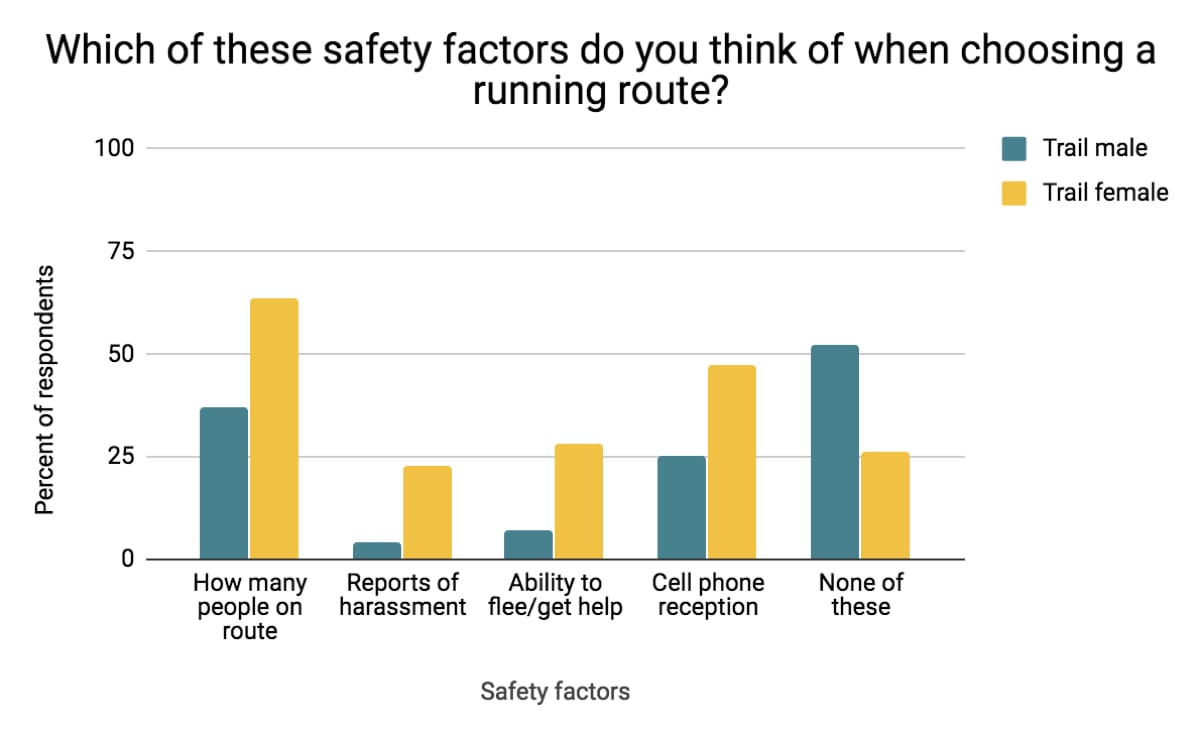 This gender difference held true on the roads as well. Female trail and road runners consider two of these safety factors far more often than males. But check out how trail running females and road running males consider reports of harassment on a route at just-about-equal levels! See this data in chart form.
This gender difference held true on the roads as well. Female trail and road runners consider two of these safety factors far more often than males. But check out how trail running females and road running males consider reports of harassment on a route at just-about-equal levels! See this data in chart form.
Other Demographics Trends
Once again, trail running experience was a moderating influence. The more years you run, the less you consider these precautions. See this data in chart form.
Similarly, environment impacted responses. Rural/remote-environment runners considered these safety factors less than their city-and-suburb-dwelling counterparts. This makes decent sense as we recall that trail runners from rural/remote environments have significantly less concern about being assaulted and they think trail running is significantly more safe than road running. See this data in chart form.
Question 7: Have you done any of the following [safety behaviors] specifically because of concerns about your safety due to humans while trail running? Check all that apply.
View the original survey and read this question in full.
Only about a third of trail runners reported they’d never changed their behavior due to concerns about other people. Running with a phone and telling someone where you’re running were the two behaviors trail runners adopted with the greatest frequency. See this data in chart form.
Women Versus Men
Stark differences exist between women and men again. In fact, female trail runners do each of these behaviors at least twice as much as men do. And when it comes to running with other people for safety, women seek out partners four times as much as men. They also carry weapons or defensive spray almost four times as much as men. And they try to run during daylight hours almost four times as much as men.
Perhaps most striking is the number of men who never take any of these safety precautions. A male trail runner is four times more likely than a woman to just head out the door without any of these safety precautions.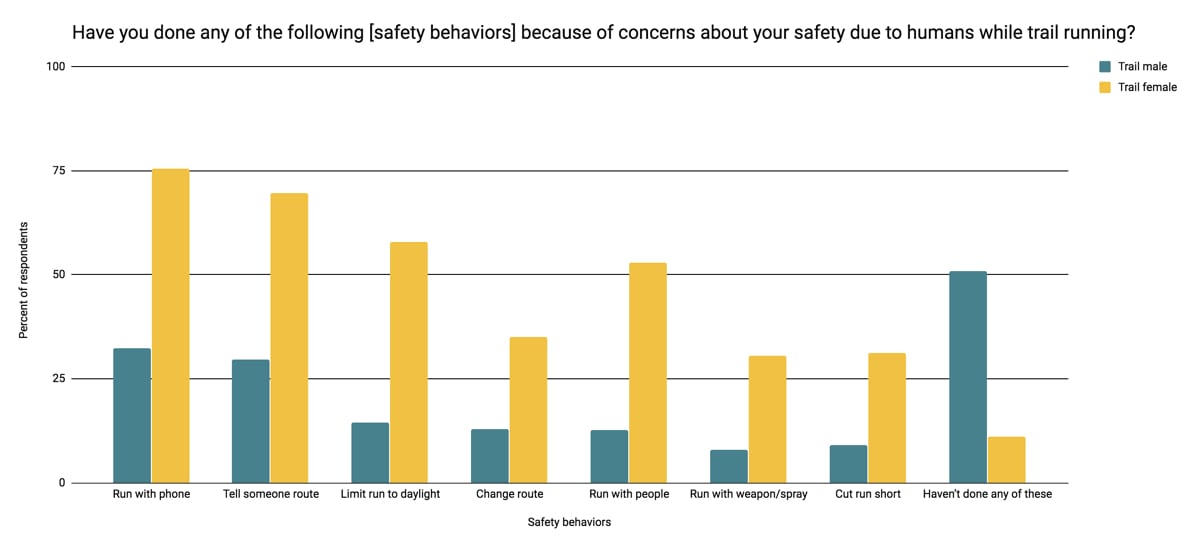
The enormous gender discrepancy between safety behavior among trail runners reflects the discrepancy Runner’s World found among road runners. There are some notable differences we’d like to call your attention to, however. Curiously, both female and male road runners are slightly more likely to tell someone their running route than trail runners are. Both female and male road runners are more likely to change their route due to safety concerns than their trail running compatriots. Finally, we notice that female trail runners say they choose to run with other people for human-safety reasons with a frequency that sets them apart from both gender trends and their female road-running counterparts. See this data in chart form.
Other Demographics Trends
Where in the world respondents live also affected how they answered this question. European trail runners indicate that they take the seven safety precautions offered by this question significantly less than residents of USA/Canada and other places in the world. See this data in chart form.
Question 9: Have you ever cancelled a trail run specifically because of concerns about your safety due to humans?
View the original survey and read this question in full.
Phew, the vast majority of respondents said they had not canceled a run because of concerns over safety due to humans. See this data in chart form.
Women Versus Men
Between men and women, female trail runners have cancelled a run due to human-safety concerns with nearly five times more frequency than men. Oof.
Other Demographics Trends
Age is not a factor in whether a trail runner cancels a run due to safety concerns. Again, experience is. The more years trail running, the less likely a runner is to cancel a run. It’s fascinating that time on trails and not time on earth informs this answer. Also, given that this question asks runners if they’ve “ever” cancelled a run, those runners with a lot of years of experience have more time over which they could have done so, yet they reported cancelling with less frequency. See this data in chart form.
North American regions had a subtle but statistically viable effect on how respondents of those regions answered this question. It is the Canadians and those from the U.S. Mountain region who canceled their runs the least, and runners from the U.S. Northeast who canceled their runs the most. See this data in chart form.
Runners’ Experiences
The survey asked 3 questions about experiences trail runners have with verbal harassment and inappropriate behavior.
Question 2: Which of the following [inappropriate behaviors] have you experienced while trail running? Check all that apply.
View the original survey and read this question in full.
We are happy to report that the overall incidence of inappropriate behavior on the trails was low. We are a bit less happy to report that the incidence of unsolicited-advice-giving was… not as low, with more than 4 out of every 10 respondents saying they had received it while trail running. See this data in chart form.
At this point, you are probably not surprised to learn there are strong differences in the way that men and women answered this question, right? Here we go: females recorded higher incidences of inappropriate behavior than males carte blanche. Female trail runners were five times as likely to be sexually propositioned while trail running than males, and four times as likely to have someone follow them on a trail run than male runners. Yuck.
The answers for which there were much smaller gaps in incidence between genders were unsolicited advice and lewd hand gestures. Turns out, people give both women and men plenty of unsolicited advice and it also turns out that men are also the unfortunate recipients of lewd hand gestures. Double yuck.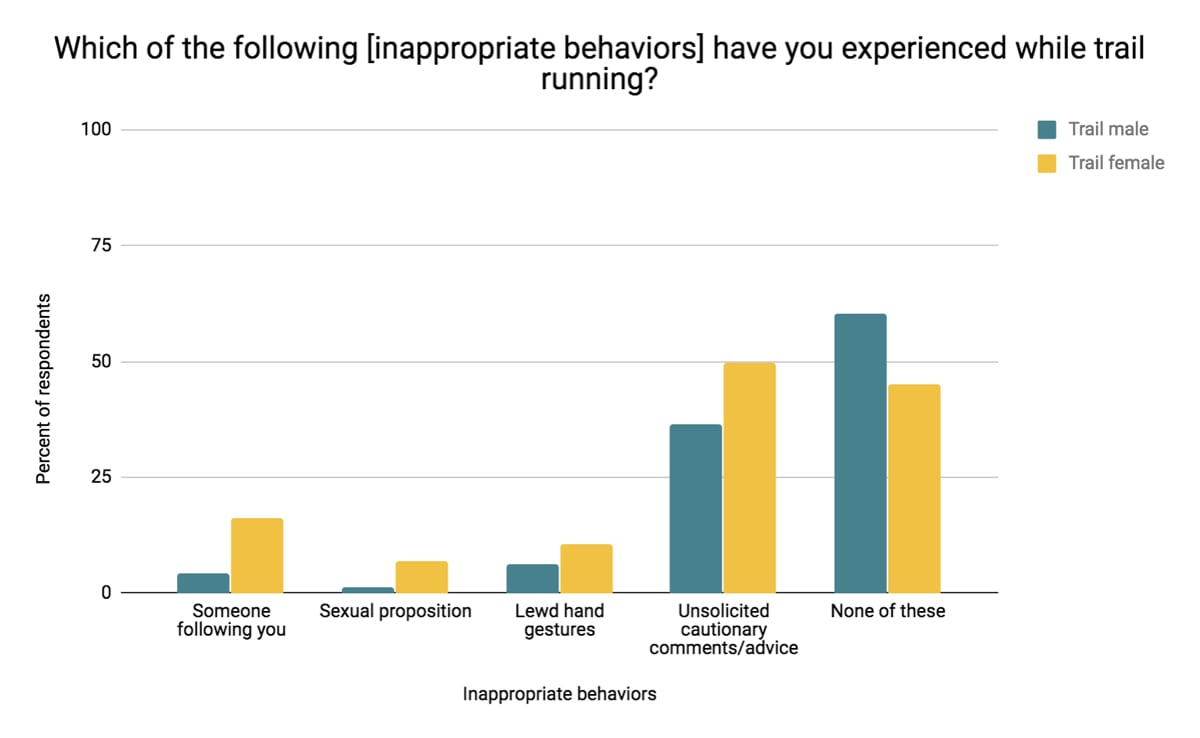 Let’s compare the answers of trail runners and road runners. First, gender trends remain consistent between male and females both on the trail and road. Second, and notably, road running females experience these two forms of inappropriate behavior at a much greater frequency than trail females: they are followed twice as often and sexually propositioned three times as often. Finally, while road running men and trail running men report that they are sexually propositioned at nearly equal rates, road men report they are followed significantly more than trail men. See this data in chart form.
Let’s compare the answers of trail runners and road runners. First, gender trends remain consistent between male and females both on the trail and road. Second, and notably, road running females experience these two forms of inappropriate behavior at a much greater frequency than trail females: they are followed twice as often and sexually propositioned three times as often. Finally, while road running men and trail running men report that they are sexually propositioned at nearly equal rates, road men report they are followed significantly more than trail men. See this data in chart form.
Question 6: When trail running, how often do you get unsolicited whistles, cat calls, sexual remarks, or remarks about your body?
View the original survey and read this question in full.
Trail runners far and away report that these forms of verbal harassment happen “rarely” or “never.” Um, yay?! See this data in chart form.
Not to beat a dead horse, but female trail runners have a different experience than their male counterparts. 16.1% of female trail runners reported being verbally harassed “sometimes,” “often,” or “most of the time” on runs. Compare this to 2.7% of men. Moreover, most male trail runners report they’ve never experienced verbal harassment, while less than half of female runners said the same. You betcha’, gender trends remain consistent between males and females on the road and trail. Given that road running females experience inappropriate behavior at a much greater frequency than trail running females, we should probably expect them to experience verbal harassment with greater frequency, too. Indeed, road females experience verbal harassment “sometimes,” “often,” or “most of the time” more than 2.5 times as often as trail females. See this data in chart form.
You betcha’, gender trends remain consistent between males and females on the road and trail. Given that road running females experience inappropriate behavior at a much greater frequency than trail running females, we should probably expect them to experience verbal harassment with greater frequency, too. Indeed, road females experience verbal harassment “sometimes,” “often,” or “most of the time” more than 2.5 times as often as trail females. See this data in chart form.
Question 8: How much does receiving unsolicited comments or attention bother you when you trail run?
View the original survey and read this question in full.
This is a sad fact: Almost 40% of respondents indicate that they are “somewhat” or “a lot” bothered by unsolicited comments or attention. See this data in chart form.
Women Versus Men
Female trail runners are unquestionably more bothered by unsolicited comments and attention than male trail runners are.
However, perhaps the most attention-getting data point here is that 20% of males reported they feel “somewhat” or “a lot” bothered by unsolicited comments or attention. Why has this captured our attention? Because the rates at which males reported inappropriate behavior and verbal harassment were quite low except for their reporting of unsolicited comments:
- Unwanted following: 4.2%
- Sexual proposition: 1.3%
- Lewd hand gestures: 6.4%
- Unsolicited cautionary comments or advice: 36.4%
And also recall that 2.7% of men report experiencing verbal harassment “sometimes,” “often,” or “most of the time” on trail runs.
Are trail running men underreporting inappropriate behavior and verbal harassment? Does being subjected to unsolicited comments or advice at significant frequency cause trail running men to feel bothered at a higher rate than would be expected for their overall reporting of small amounts of inappropriate behavior and verbal harassment? There is much to unpack here.
It’s no surprise that gender trends remain consistent between males and females on the road and trail. But, wow, both female and male road runners are much more bothered by unsolicited comments and attention than their trail running counterparts.
And if we were surprised by the degree to which trail running men feel bothered by unsolicited comments and attention based upon their very low reporting of inappropriate behavior and verbal harassment, then we should be knocked off our rockers by how bothered by unsolicited comments and attention road running men feel. 35% of road running men report feeling “somewhat” or “a lot” bothered by unsolicited comments or attention!
See this data in chart form.
Other Demographics Trends
We are interested to see that European respondents report feeling bothered by unsolicited comments and attention the least, and USA/Canada respondents the most. See this data in chart form.
Trail runners in urban environments report feeling the most bothered by unsolicited comments and attention, and those in rural/remote environments report it the least. See this data in chart form.
As both trail running experience and age increase, the degree to which respondents feel bothered by unsolicited comments and attention decreases. However, it’s the years-of-experience demographic where we see the most marked decrease. See this data in chart form.
Conclusions
We set out on this survey adventure concerned about trail running safety and wondering whether this aspect of trail running might be significantly different for women and men. Do female trail runners have different experiences, concerns, and behaviors than men do? Our survey says yes. Oh, yes. Wow, yes.
As a whole, we trail runners don’t experience much danger or harassment from other people when we’re out on the trails. And, by and large, the trail running world seems more hospitable than road running, as our levels of concern, reports of inappropriate behavior and verbal harassment, and general sentiment of feeling bothered by all that are lower than those of our road running partners afoot.
It’s interesting to look at the variation in the way trail runners responded based upon where we live, the kind of environment we trail run in, our amount of trail running experience, and, at times, our age. But it’s the fact that women and men consistently have a different experience and different decision-making process when they head out the door that merits the most recognition. That is, analysis showed that the gender-based variations seen in the answers of all 10 safety-related questions are statistically significant.
We want to be clear: a person’s gender affected the way they answered each and every one of the survey’s safety-related questions. No other demographic surveyed produced this strong of a response.
We’d never thought about this difference before. Had you? More importantly, what do we do with this knowledge? What do we do knowing a good number of women are concerned about their safety and are more likely to be harassed or threatened? Should anyone be giving unsolicited advice to women or men out on the trail? How do we make trail running not only be safer but feel better for everybody? Coming soon in another article, we’ll consider these questions and more. Please share your thoughts with us!
Thank You
When it comes to this kind of project, it takes a village, and we were fortunate to work with great people. Thanks to the present and past team at Runner’s World for their permission to model our survey after their “Running While Female” survey, including Melissa Stephenson, Michelle Hamilton, and Meghan Kita. We owe gratitude to Rachel Allison, Alicia Eno, and Donald Schoolmaster for sharing their expertise and advising in multiple aspects of social science. They helped us shape the survey questions, create the survey tool, and analyze and interpret data. Thank you to Sam Pilgrim who developed our results infographic. Thanks to Meghan Hicks for setting us on this path and providing great ideas and her own insight on the data. Thank you to Bryon Powell for his editor’s eye.
[Editor’s Note: Thanks to Liza Howard for penning the body of the article with collaboration from Meghan Hicks. Thanks to Pam Smith for her work on the project development, on earlier drafts, and data analysis, and to Gina Lucrezi for her involvement in the survey and the story’s early development. – Bryon Powell]
Giveaway Winners
We offered prizes that were raffled off at the end of the survey to its participants as incentive for completing the survey. We’ve conducted the raffle and contacted winners privately. Thanks for participating in the survey, and thanks to the brands who offered up raffle prizes, including Altra, Columbia Montrail, Hoka One One, inov-8, Jaybird, Julbo, Smartwool, Suunto, The North Face, Ultimate Direction, and UltrAspire!
Call for Comments (from Meghan)
We recognize that this is a sensitive issue for many members of our community, and so we ask for civility in all comments. Of course, you are welcome to disagree, but we ask you to do so constructively. Thank you in advance for contributing to a healthy, helpful conversation.
- What observations can you add based on the survey results that aren’t discussed in this article?
- What are your thoughts on the results of the survey?
